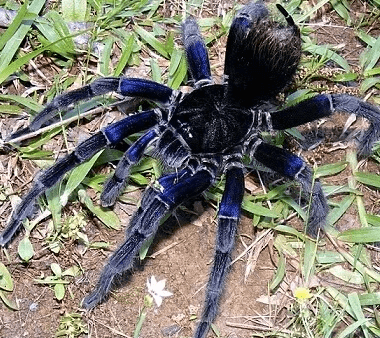Pamphobeteus antinous, known for its stunning appearance and intriguing behavior, is a tarantula species that has captured the fascination of arachnid enthusiasts. While these tarantulas are a joy to observe, handling them requires careful consideration and knowledge. In this comprehensive guide, we will explore the essential aspects of handling Pamphobeteus antinous, ensuring the safety and well-being of both the tarantula and the handler.
Understanding Pamphobeteus Antinous
Before attempting to handle these tarantulas, it’s crucial to understand their natural behavior and characteristics:
1. Size and Appearance
Pamphobeteus antinous tarantulas are among the larger species, with females reaching leg spans of up to 8 inches (20 centimeters). Their striking blue-black bodies, adorned with vibrant patterns, make them a visual delight.
2. Temperament
While not considered aggressive, Pamphobeteus antinous tarantulas can exhibit defensive behavior when they feel threatened. They may raise their front legs, flick urticating hairs, or even bite if they perceive a threat.
3. Venom
Their venom is not medically significant to humans, but bites can still be painful. Some individuals may also experience mild allergic reactions to tarantula venom. Therefore, it’s essential to exercise caution.
Handling Guidelines
Handling Pamphobeteus antinous tarantulas should be a rare and well-thought-out activity. Here are the guidelines to follow:
1. Safety First
- Always prioritize safety when handling tarantulas. Have a plan in place in case the tarantula becomes agitated or attempts to escape.
2. Choose the Right Time
- Opt for handling during the tarantula’s most docile periods, typically in the evening or when the tarantula is less active.
3. Wash Hands Thoroughly
- Before handling, wash your hands with mild soap and water. Ensure that there are no residues of lotions or perfumes on your skin.
4. Use Proper Handling Tools
- Tarantula handling tools, such as soft brushes or plastic containers, can be used to gently coax the tarantula onto your hand.
5. Approach Slowly
- Approach the tarantula’s enclosure calmly and slowly. Abrupt movements can startle them.
6. Observe Body Language
- Pay close attention to the tarantula’s body language. If it raises its front legs, flicks hairs, or becomes agitated, do not attempt to handle it.
7. Hand Placement
- When handling, gently slide your hand under the tarantula’s body, allowing it to walk onto your hand voluntarily. Avoid sudden grabs or pressure.
8. Keep Close to the Ground
- If the tarantula should fall, it’s best to keep the handling session close to the ground to minimize the risk of injury.
9. Limit Handling Time
- Keep handling sessions short and infrequent. Extended periods of handling can stress the tarantula.
10. Avoid Handling During Molting
- Do not handle a tarantula that is in the process of molting, as they are extremely vulnerable at this time.
Handling Risks and Considerations
Handling Pamphobeteus antinous tarantulas carries inherent risks, and it’s essential to be aware of these:
1. Stress
- Handling can be stressful for tarantulas, and excessive or rough handling can harm them. Stress can also lead to health issues.
2. Defensive Behavior
- Tarantulas may exhibit defensive behaviors when handled, which can result in biting or flicking urticating hairs.
3. Escape
- Tarantulas are quick and agile climbers. A fall can lead to injury or escape, which can be challenging to rectify.
4. Allergic Reactions
- Some individuals may have allergic reactions to tarantula venom. It’s essential to be aware of any allergies and take precautions.
When Not to Handle?
There are specific situations when handling should be avoided entirely:
1. During Molt
- Avoid handling during the molting process, as tarantulas are vulnerable and prone to injury.
2. Post-Molt
- After molting, give the tarantula time to harden its exoskeleton before considering handling.
3. Agitated Behavior
- If the tarantula is displaying defensive or agitated behavior, do not attempt to handle it.
4. Health Issues
- If the tarantula is showing signs of illness or injury, handling should be postponed until it has recovered.
Handling Pamphobeteus antinous tarantulas can be a rewarding experience for dedicated enthusiasts, but it should always be approached with caution, respect, and a deep understanding of the tarantula’s needs and behavior. By following the guidelines outlined in this article and prioritizing the safety and well-being of both the tarantula and the handler, you can enjoy a closer connection with these magnificent creatures while ensuring their continued health and happiness in captivity.
Image courtesy: https://happyforest.store/product/pamphobeteus-antinous-tarantula/
